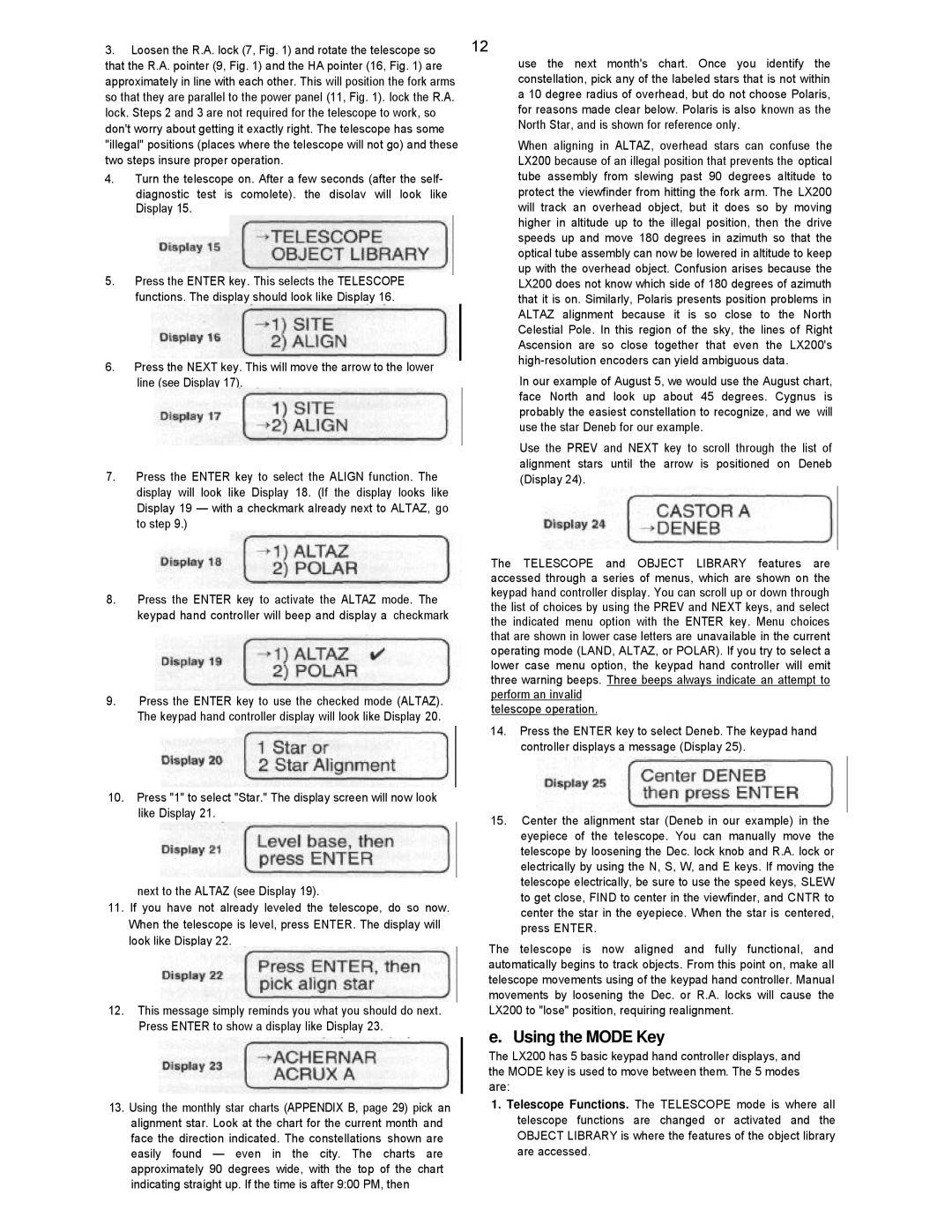3.Loosen the R.A. lock (7, Fig. 1) and rotate the telescope so that the R.A. pointer (9, Fig. 1) and the HA pointer (16, Fig. 1) are approximately in line with each other. This will position the fork arms so that they are parallel to the power panel (11, Fig. 1). lock the R.A. lock. Steps 2 and 3 are not required for the telescope to work, so don't worry about getting it exactly right. The telescope has some "illegal" positions (places where the telescope will not go) and these two steps insure proper operation.
4.Turn the telescope on. After a few seconds (after the self- diagnostic test is comolete). the disolav will look like Display 15.
5.Press the ENTER key. This selects the TELESCOPE functions. The display should look like Display 16.
6.Press the NEXT key. This will move the arrow to the lower
line (see Display 17).
7.Press the ENTER key to select the ALIGN function. The display will look like Display 18. (If the display looks like Display 19 — with a checkmark already next to ALTAZ, go to step 9.)
8.Press the ENTER key to activate the ALTAZ mode. The keypad hand controller will beep and display a checkmark
9.Press the ENTER key to use the checked mode (ALTAZ). The keypad hand controller display will look like Display 20.
10.Press "1" to select "Star." The display screen will now look like Display 21.
next to the ALTAZ (see Display 19).
11.If you have not already leveled the telescope, do so now. When the telescope is level, press ENTER. The display will look like Display 22.
12.This message simply reminds you what you should do next. Press ENTER to show a display like Display 23.
13.Using the monthly star charts (APPENDIX B, page 29) pick an alignment star. Look at the chart for the current month and face the direction indicated. The constellations shown are easily found — even in the city. The charts are approximately 90 degrees wide, with the top of the chart indicating straight up. If the time is after 9:00 PM, then
12
use the next month's chart. Once you identify the constellation, pick any of the labeled stars that is not within a 10 degree radius of overhead, but do not choose Polaris, for reasons made clear below. Polaris is also known as the North Star, and is shown for reference only.
When aligning in ALTAZ, overhead stars can confuse the LX200 because of an illegal position that prevents the optical tube assembly from slewing past 90 degrees altitude to protect the viewfinder from hitting the fork arm. The LX200 will track an overhead object, but it does so by moving higher in altitude up to the illegal position, then the drive speeds up and move 180 degrees in azimuth so that the optical tube assembly can now be lowered in altitude to keep up with the overhead object. Confusion arises because the LX200 does not know which side of 180 degrees of azimuth that it is on. Similarly, Polaris presents position problems in ALTAZ alignment because it is so close to the North Celestial Pole. In this region of the sky, the lines of Right Ascension are so close together that even the LX200's high-resolution encoders can yield ambiguous data.
In our example of August 5, we would use the August chart, face North and look up about 45 degrees. Cygnus is probably the easiest constellation to recognize, and we will use the star Deneb for our example.
Use the PREV and NEXT key to scroll through the list of alignment stars until the arrow is positioned on Deneb (Display 24).
The TELESCOPE and OBJECT LIBRARY features are accessed through a series of menus, which are shown on the keypad hand controller display. You can scroll up or down through the list of choices by using the PREV and NEXT keys, and select the indicated menu option with the ENTER key. Menu choices that are shown in lower case letters are unavailable in the current operating mode (LAND, ALTAZ, or POLAR). If you try to select a lower case menu option, the keypad hand controller will emit three warning beeps. Three beeps always indicate an attempt to perform an invalid
telescope operation.
14.Press the ENTER key to select Deneb. The keypad hand controller displays a message (Display 25).
15.Center the alignment star (Deneb in our example) in the eyepiece of the telescope. You can manually move the telescope by loosening the Dec. lock knob and R.A. lock or electrically by using the N, S, W, and E keys. If moving the telescope electrically, be sure to use the speed keys, SLEW to get close, FIND to center in the viewfinder, and CNTR to center the star in the eyepiece. When the star is centered, press ENTER.
The telescope is now aligned and fully functional, and automatically begins to track objects. From this point on, make all telescope movements using of the keypad hand controller. Manual movements by loosening the Dec. or R.A. locks will cause the LX200 to "lose" position, requiring realignment.
e. Using the MODE Key
The LX200 has 5 basic keypad hand controller displays, and the MODE key is used to move between them. The 5 modes are:
1.Telescope Functions. The TELESCOPE mode is where all telescope functions are changed or activated and the OBJECT LIBRARY is where the features of the object library are accessed.

